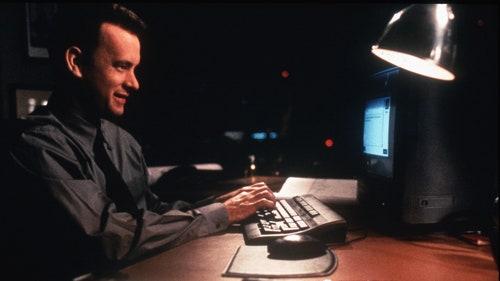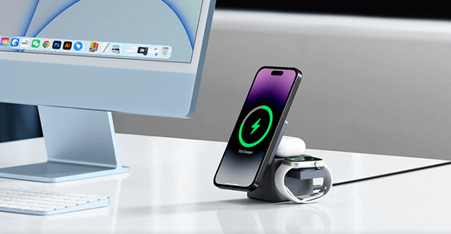Right around the age when you were supposed to know whether you wanted to become a fireman or a doctor, I was certain that I wanted to work as a grocery-store clerk. I found the sounds of the keystrokes on the cash register enormously pleasing. Growing up, I often heard my father, a professional translator, extol the virtues of a pleasant-sounding keyboard: neither too clackety nor too hollow-sounding, with just the right amount of rebound. In college, I envied the students not with the shiny MacBooks but those with the I.B.M. Thinkpad T40—to this day, the most beautiful-sounding laptop, to my ears. Indeed, I.B.M. really knew how to make a keyboard: there is an entire fan site dedicated to the
I.B.M. model M keyboard
, complete with the
full text of the patent
for the “buckling spring snap torsional actuator,” granted in 1978.
Last year, Tom Hanks wrote an ode to the typewriter in the form of an
Op-Ed for the New York Times
, in which he revealed that he’s been collecting the things since 1978. Then, last week, the actor, who
signs his tweets “Hanx,”
released the “Hanx Writer,” an
iPad app
that he helped to create with the company Hitcents. It simulates a typewriter keyboard—clacks, clangs, and all. Within days, the Hanx Writer had rocketed to No. 1 in the App Store, where it is the most popular app in both the “Productivity” category and across all free apps. Two nights ago, when I downloaded it, it was featured as an “Editor’s Choice.”
The app doesn’t do a whole lot; with only four options (you can turn off “Modern Delete” and opt to “x” out your typos), it's only slightly more basic than some of the simplest text-editing software available. But it is free, with paid upgrades for things like different typewriter models, such as the Hanx 707 and the Hanx Golden Touch, and the ability to change ribbon and paper colors. Plus, it’s irresistibly fun to peck at. As
TechCrunch points out
, it’s probably not just that the app has a celebrity spokesperson—Justin Bieber’s selfie app didn't perform nearly as well in the App Store. And it's not exactly that everyone who’s downloading it is trying to adopt an unplugged lifestyle—this is just a way to remember it fondly, much how Instagram simulates the effect of film with nostalgically named filters.
Typewriter enthusiasts are nothing new. This summer, there was a Kickstarter campaign to raise money for a vintage-style typewriter keyboard cringe-inducingly called the “
Qwerkywriter
,” complete with U.S.B. port and Bluetooth. If he wanted to, Hanks could even convert one of his existing typewriters into an external keyboard for his iPad, using a kit from
U.S.B. Typewriter
for a doubly clackety (and probably disorienting) Hanx Writer experience. Last summer in New York, a young man named
Christopher Hermelin
brought his brown Royal Safari to the High Line, where he sat on a bench with a sign that read “One-of-a-kind, unique Stories While You Wait. Sliding Scale–Donate What You Can!” He

quickly drew the ire and ridicule
of
the fussiest corners of the Internet
when a photo of him, crucially obscuring his explanatory sign, was
posted to Reddit
. (“So when will the Sumerian clay tablets be resurfacing the streets of hipster nyc?” one commenter wrote.) But Hermelin’s embrace of the retro look was a mere distraction from the fact that he was selling a tangible product. More importantly, the underemployed, self-proclaimed “Roving Typist” gained something from the act of producing a physical object—the feeling of being at work.
That feeling of doing is beautifully recreated with the Hanx Writer app, but the good-looking document that results is only a simulacrum of the real thing—an inky, almost embossed piece of paper. In his Op-Ed, Hanks writes, “The physicality of typing engenders the third reason to write with a relic of yesteryear: permanence.” He continues, “Short of chiseled words in stone, few handmade items last longer than a typed letter, for the ink is physically stamped into the very fibers of the paper."
But, more than anything, the Hanx Writer is about making noise. The glorious simplicity of the app is that it sounds like what it does; it achieves the audio equivalent of skeuomorphism, the design principle of recreating the familiar materials and visual cues of old objects. Here at
The New Yorker
, several of our staffers remember the days of the "typing pool," where manuscripts and other documents were typed for further processing into magazine pieces. (It’s where
Nancy Franklin
got her start
.) One editor recalls that you could tell whether your neighbor was being productive that day just by the typewriter sounds coming out of his office (thus pressuring you to get down to work). As an easily distracted reader, I, for one, am relieved to have missed what Hanks calls the “focus-stealing racket,” but only because, in these days of of razor-thin Mac keyboards, the office is eerily quiet.
Steven Levy
has written about how one particular model
of typewriter had a cult following among writers. In Nora Ephron’s “You’ve Got Mail,” Frank Navasky, a writer for the New York
Observer
(based on the real writer Ron Rosenbaum) is so obsessed with the sound of his
Olympia Report deLuxe
that he keeps one at his girlfriend’s apartment and one at his own. In one scene, he doesn’t quite believe in his own words until he sits down to type them.
As he pounds out his ineloquent thoughts
, he reads along: “You are a lone reed waving in the breeze, standing strong and tall in the corrupt sands of commerce.” When he hands Meg Ryan’s character the sheet of paper, she repeats the line as she walks away, an actor practicing her scene. Of course, one of the most important typists in that movie, Joe Fox, is played by Tom Hanks. (You can practically hear the keystrokes behind a recurring motif, the spelling of his last name: F-O-X.) Maybe Hanks’s next app will connect like-minded AOL nostalgists, who can sigh at the sounds of a dial-up modem and the chime of “You’ve Got Mail.”









